
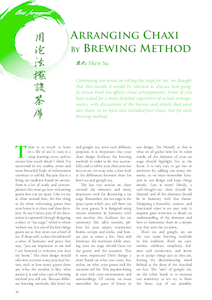 |
|
There is so much to learn in a life of tea! It truly is a steep learning curve, and no matter how much detail I think I've uncovered in my studies, more and more beautiful buds of information continue to unfold. Because this is a living tea tradition based on service, there is a lot of study and contemplation that must go into welcoming guests into our tea space. Like we say so often around here, the first thing to do when welcoming guests into your home is to clean and then decorate. At our Center, part of the decoration is expressed through designing a chaxi, or "tea stage," which is where we brew tea. It is one of the first things guests see as they enter our school of tea. If done well, a chaxi should instill a sense of harmony and peace that says, "you are important to me and I am honored to welcome you into my home." The chaxi design should take into account many practical factors, such as how many guests there are, what the weather is like, what season it is and what type of brewing method you will use. Because different brewing methods, like bowl tea and gongfu tea, serve such different purposes, it is important that your chaxi design facilitate the brewing method. In order to do that successfully and to refine your chaxi practice into an art, we must take a close look at the differences between chaxi for bowl tea and gongfu tea.
The last two articles on chaxi covered the elements and many important tools for decorating a tea stage. Remember, the tea stage is the space upon which you will brew tea for your guests. It is designed using certain elements in harmony with one another that facilitate the tea ceremony, like table runners, pillows for your teapot, wastewater basins, scoops and sticks, and bonsai, just to name a few. First and foremost, the intention while creating your tea stage should focus on the guests and the occasion. This is most important! Don't design a chaxi based on what you want, but rather, on what your guests and the occasion call for. This requires being in tune with your environment and surroundings. Of course, we must remember the guest of honor in our design, Tea Herself, as this is what we all gather here for. In other words, all the elements of your tea stage should highlight Tea as the focus. It is very easy to get lost in aesthetics by adding too many elements, so we must remember function in our design and keep things simple. Less is more! Finally, a well-thought-out chaxi should be themed, and all the elements should be in harmony with that theme. Designing a beautiful, creative, and functional chaxi is no easy task; it requires great attention to detail, an understanding of the elements and how to harmonize them in a simple way that suits the occasion.
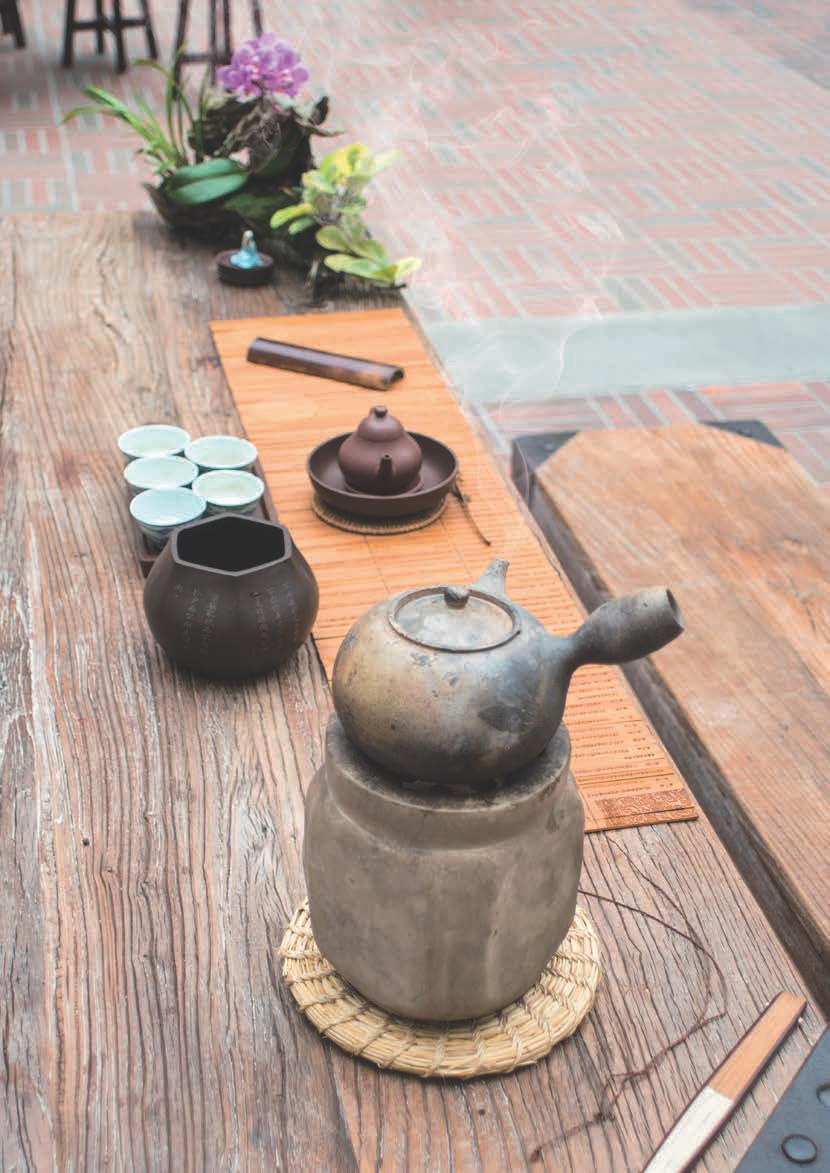
Bowl tea and gongfu tea are the two main brewing methods in this tradition. Bowl tea ceremonies celebrate simplicity, balance and connection, and invite us to accept things just as they are, leaving the discriminating mind behind at the door of the thatched tea hut. The "aim" of gongfu tea, on the other hand, is to increase our sensitivity as we try to brew the finest cup of tea possible, paying great attention to detail in every slow and graceful movement. There are different tea stages more suitable in their design to facilitate the function of each brewing method. Each method, therefore, requires a slightly different set of elements, arranged in a slightly different way.
Some of the most obvious differences in chaxi design for different brewing methods can be seen in the teaware. Once you have chosen a brewing method, designing your chaxi with the necessary teaware in mind will be essential. Designing a tea stage to accommodate teaware specific to a particular brewing method will help you refine your chaxi practice. A tea stage that functions well for one brewing method might not for another, so we must know our teaware intimately, like a close friend, in order to design a chaxi appropriate for such teaware.
In bowl tea, your design must account for the use of bowls, a side-handle tea pot, or the combination of both, depending on what style of bowl tea you choose. For original bowl tea, you will just need to account for the use of bowls. For side-handle pot tea, you will need to account for both pieces of teaware. There needs to be sufficient room for all of the teaware, which depends on the number of guests and chosen brewing method. This also means that other elements within your design should not be in the way when you hand out the bowls and take them back in. That's part of the reason why a chaxi for larger bowl tea gatherings should be simpler to account for the additional challenges that arise when serving more people.
In gongfu tea, the teaware is very different and is chosen to bring out the most the tea has to offer. A properly designed gongfu chaxi should create space for a gongfu tea pot, tea boat, tray for cups, the cups themselves, coasters and a wastewater basin (jin shui). In this tradition, it is quite crucial that the pot be made of zisha (purple-sand clay) and that the cups be made of porcelain. By doing gongfu tea experiments, you can see for yourself that the relationship tea has with these specific materials is not arbitrary and in fact goes a long way towards brewing a finer cup of tea. This is not to say you can't design a chaxi or brew gongfu tea without these elements, but they are ideal, and gongfu tea is about striving towards the ideal.
What mainly differs between gongfu tea and bowl tea chaxi is the shape, size, and arrangement of the elements. In bowl tea, the teaware, like side-handle pots and bowls, are larger than the teaware used in gongfu tea, and so they often require more space on the tea table. Chaxi for bowl tea, then, often ends up using longer and narrower tea cloth (chabu), but not always. This creates space for all the most common elements, like scoops and sticks, lid rests, a boat or pillow, the wastewater container and the more decorative elements, such as bonsai, simple flower arrangements, leaves, flower petals, rocks, etc. Chaxi for bowl tea is convenient in that it is easy to adapt to larger or smaller tea spaces, for larger or smaller tea gatherings. While the stage for bowl tea may appear more form-oriented, function should be skillfully integrated into the design.

Gongfu tea is generally reserved for smaller gatherings of one to five guests. Such a chaxi, therefore, tends to be more function-oriented and the elements are usually laid out in a smaller space. We often use shorter and wider chabu to help contain the elements and teaware around the brewer. This keeps everything necessary close at hand to better preserve temperature and facilitate slow, gentle, graceful movements. The scoop and stick used in gongfu chaxi are often smaller than in bowl tea. The scoop is smaller because smaller amounts of tea are used when brewing gongfu. The stick is smaller because it needs a pointed or sharp end to clean the spout should it become clogged. The elements are limited to the bare essentials necessary to brew the finest cup of tea, but not without the occasional addition of a small cha chong, or "tea critter," which invites certain qualities to a tea ceremony: for instance, a tortoise invites abundance and longevity, while a water buffalo symbolizes good fortune and a sacred connection to the Earth.
The space for the jin shui is a small but major difference in the layout for bowl tea versus gongfu tea. In bowl tea, the jin shui is usually only brought out in the beginning to cleanse the teaware and then placed away out of sight when not in use. Whereas with gongfu tea, the design of a chaxi must hold space for a jin shui throughout the entire tea ceremony, as it is used in between each infusion to collect discarded water from the cups, tray and boat. That's why in gongfu tea, a very elegant jin shui can also second as a decorative element within the design because it is always on the table. It is important to place the jin shui on the off-hand side of your chaxi design. Can you guess why? It's a matter of function: when you need to empty the water from the tea boat (cha chuan) that your pot rests in, your off-hand gently and carefully lifts it and empties the water into the jin shui, conveniently placed on the off-hand portion of the tea stage. For most people, this means the jin shui will be placed in the left portion of your chaxi. This is so important for the flow of your ceremony because it allows you to use both hands at the same time without needing to reach across anywhere. (Watch April's Bonus Video to learn more!)
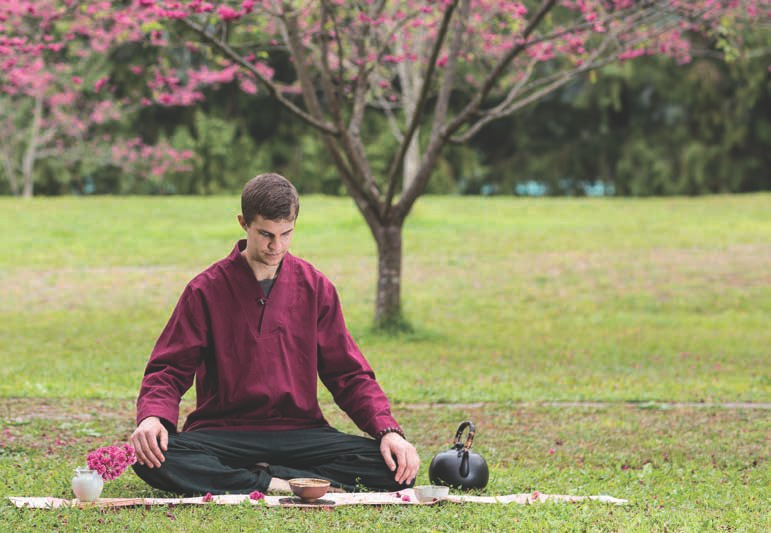

A billion perfect sakura, or only the one someone left in my bowl.
In general, a chaxi should be designed with the function of the brewing method in mind, along with all the other practical factors of the day. We must, therefore, understand the function of each brewing method and all the necessary elements required to serve the tea we have chosen.
Possibly most important is that we don't take these differences in chaxi design and turn them into a formula for arranging our tea stage. There are definitely exceptions where a chaxi design works perfectly well for either brewing method. But highlighting the differences in the beginning will help us refine our chaxi practice until it becomes more natural. In order to work from gross to subtle, from general to refined, we should arrange more and more chaxi, which means we should serve more and more tea!
More important than reading articles on chaxi is actually creating them yourself and starting a dialogue with your teaware and chaxi elements. You can ask them and get a feel for whether they work together to meet the needs of your guests and the occasion. The secret to any element in any chaxi design, be it for bowl tea or gongfu tea, is that they are alive with an energy. You will find more guidance in talking to your chaxi than reading about them.
For the purposes of this article, I will describe four scenarios, considering all of the themes, as well as practical factors of four unique chaxi. With the examples on the following four pages, two for gongfu and two for bowl tea, we can explore what goes into designing a tea stage and why, and also highlight some of the differences between the chaxi used in gongfu versus bowl tea brewing.
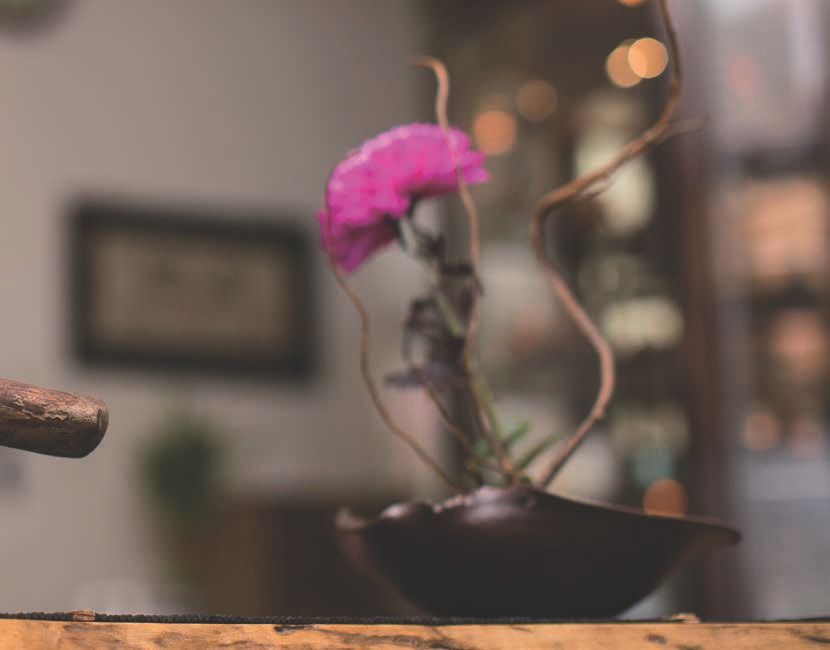



If you haven't already, look over this chaxi carefully and see what theme comes to mind before reading on. Though I had a particular theme in mind when creating this layout, there is by no means a wrong interpretation. It means what it means to you! The theme that came to mind, which suited my fictional scenario, was a layperson leaving the worldly life behind to become a mountain person, or monk. Therefore, I chose the red cloth to represent the dust of the world. In ancient China, roads weren't paved, but rather bare and dusty and red from the clay. Leaving the "red dust of the world (紅塵俗世)" to become ordained reminds us that when we sit down at the tea table, we also take a temporary ordination. The tea space is one of equality, where we leave behind our ego, social status and name, none of which matters in a heart space!
The cloud and Buddha represent ascension towards our highest self. It would have been common when leaving the world to make towards the mountains in order to begin spiritual practice, become a monastic, or lead a hermit's life of solitude and self-cultivation.

This design is suitable for larger bowl tea gatherings; the elements are few, yet it utilizes a larger space nicely, focusing our attention on the center of the stage and leaving plenty of room to take in and pass out the bowls. It uses an elegant, rich-colored cloth, so I would reserve this particular chaxi for lighter teas that won't stain (or be extremely mindful if choosing to brew a darker tea). Because the colors are suggestive of red clay, earth and dust, and the theme suggests ascension, this design is warming and thus best suited to cooler weather.
I would use a chaxi of this style for five or more guests at any time of the day during cooler times of the year. Because of the nature of the theme, I would use this chaxi for deeper, more ceremonial tea gatherings with enthusiastic Chajin. Remember, tea is inclusive. There are many approaches to tea and no one is better than another. In saying that I would use this chaxi for particular guests, I do not mean to exclude other guests and their approaches to tea, but to try and best harmonize a chaxi to a particular scenario. For example, if I were making tea for a large group of my family members who approach tea as an everyday beverage, I would use a different design that would better suit the nature of that situation, but I would make it with the same intention that all bowl tea is conducive to: connection and heart space!

The path to the teahouse should be as a portal from one world to another. It should shift our focus of attention from worldly matters to transcendence, connection to Nature and simplicity. Though it may be a short path, it should express powerfully a flash of harmony and purity. The path itself, composed of rocks, moss, shrubs or many other combinations of natural elements, should be just as clean as the inside of the teahouse. In walking this way, we enter the teahouse transformed, cleansed and humbled. Stepping upwards, we take our place within the tea space, seated upright and ready to receive, as if we ourselves were a cleansed and empty bowl ready to receive the wisdom found in the leaves and hot water.
This design is suitable for smaller gatherings (one to three guests) where bowl tea is still ideal. A chaxi with a raised element of design such as this one can make serving more challenging. But when restricted to smaller tea gatherings, as I designed this one for, such challenges are often mitigated. And because the raised element of this chaxi is suited to the theme of raising something ordinary up to something extraordinary, it satisfies both function and form. That being said, any time we raise up our teaware in a chaxi design, though it may offer a sense of elevation, it also poses a slight danger to our teaware, and so should be practiced sparingly, safely and under the right circumstances, such as I have hoped to demonstrate with this example.
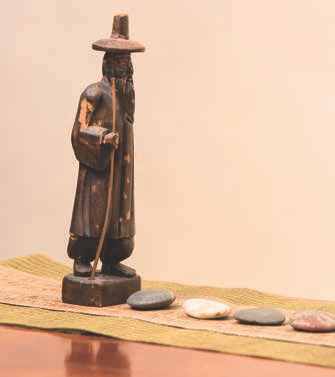
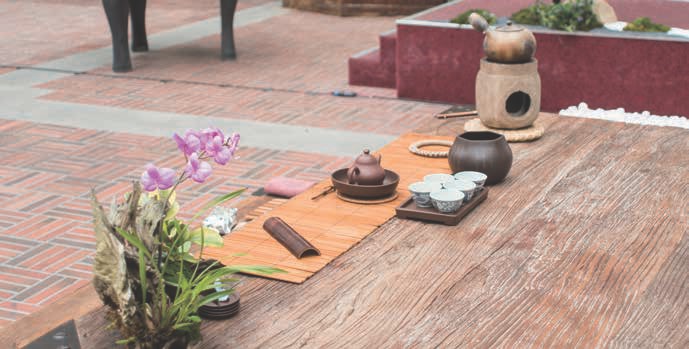
Traditionally, the four treasures of gongfu tea were the mulberry creek brazier and kettle for heating water, a purple-sand tea pot, a tea boat (often of antique porcelain, such as a reclaimed plate) and small porcelain cups. In this design, Wu De also paired those elements on a bamboo runner with the Dao De Ching engraved in it, celebrating the tradition of gongfu tea and its relationship to Daoism and self-cultivation.
We shared tea using this chaxi at a tea event we were invited to. The occasion called for gongfu tea to be served in a large open space, at designated tables, to as many as seven guests per table. We brought a traditional gongfu design to a modern tea event in a chatty environment. Without sacrificing our approach to tea, we designed this chaxi to suit the guests and the occasion, to keep the focus on the tea, to demonstrate functionality and to create a little balance by using a traditional theme in a modern environment.
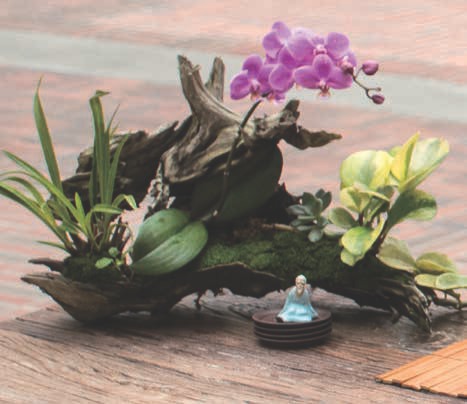
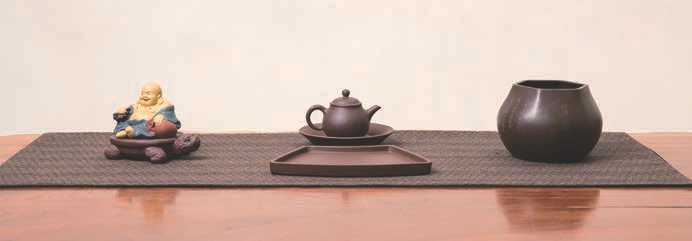
In this gongfu arrangement, I hoped to wish some Tea Sage Hut guests a joyful farewell as they continued their travels.
Though the design could accommodate more guests, it served four just fine. There is plenty of room for all the elements, though I chose to bring out the stick and scoop after the guests sat down, along with the cups, keeping it as open and simple as possible, perhaps suggesting an unobstructed journey. Normally, I wouldn't bring out the tray for the cups either until after the guests sat down; however, I knew they were traveling to Japan, and so, with the shape of the tray resembling a Japanese fan, I thought it suitable to add the tray into the design right from the beginning. Though it may be a small detail that the guests themselves might not have picked up on, the point is that it's not there arbitrarily. There was a conscious decision to bring it out, as there should be with all elements. We speak our hearts through tea; we communicate through our chaxi and then through the tea that is performed on that stage. The pattern on the tea cloth resembled a number of different roads, and of course, the Happy Buddha is merrily traveling down one of them on the back of a turtle. Notice also how the Buddha and the wastewater container are aligned to bring about a sense of overall balance and symmetry in the chaxi.

